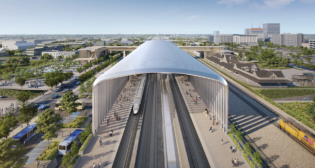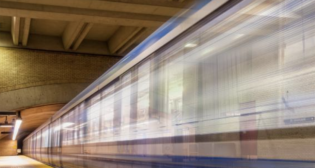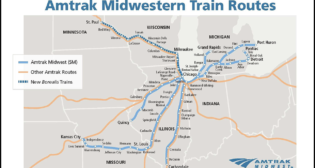
Austin MetroRail: The Little Train That Can, and Does
Written by Lyndon HenryIt's been a hard climb, but Austin's relatively small MetroRail transit service—built and operated since March 2010 by Capital Metro—is finally starting to prove its worth.
MetroRail—originally conceived in the late 1990s as a very small-scale “demonstration” line to acquaint Austinites with a taste of rail transit and show what even a small rail service could do—has been disparaged by critics since even before its approval by voters in 2004.
 Gee, you’d think they’d cut it some slack. At less than $4 million a mile (for 32 miles, linking lower downtown Austin with Leander, a sizable northwest suburb), MetroRail’s starter line, called the Red Line, surely qualifies as one of the nation’s most bargain-rate rail transit projects in modern times.
Gee, you’d think they’d cut it some slack. At less than $4 million a mile (for 32 miles, linking lower downtown Austin with Leander, a sizable northwest suburb), MetroRail’s starter line, called the Red Line, surely qualifies as one of the nation’s most bargain-rate rail transit projects in modern times.
Admittedly, it does have some disadvantages—particularly the fact that its old Southern Pacific branch line route bypasses the heart of Austin. Winding south and easterly from the northwest suburbs, the Red Line meanders north of the central city, then down through the city’s eastern half before turning west and ending up in the southeast corner of downtown—totally missing the huge University of Texas campus and the complex of government offices around the state Capitol.
In addition to MetroRail’s rather dog-legged route, there have been other problems. Operating cost constraints, a mostly single-track alignment, and a minuscule fleet capacity (6 DMUs, total, including spares) have crimped service levels and further suppressed ridership.
I’ve discussed some of these drawbacks in a previous article in this blog:
Austin LRT plan criticized … by rail advocates
…and on the Light Rail Now website:
Austin, Texas: City’s Urban Rail Plan Needs Major Overhaul
Nevertheless, MetroRail does offer attractive mobility to an important segment of travelers, and ridership has gradually been growing. Lately it’s been averaging just under 2,000 per weekday—thanks to service upgrades like midday service and, most recently, the initiation of regular Saturday service plus late-night runs Friday and Saturday.
By far, however, MetroRail’s biggest ridership surges—and greatest triumphs—have come during special events (an Austin specialty), often served by extra rail service. Indeed, it’s these occasions that really prove the value and test the mettle of rail transit, and MetroRail has proven itself up to the task, with one-day surges in the past ranging between 5,000 to 6,000 passenger-trips.
And new records were set this past March, during Austin’s internationally renowned South by Southwest (SxSW) music-arts-Internet festival. During the nine-day, mostly downtown event between March 9th and March 17th, MetroRail ridership averaged 3,859 daily rider-trips, with a huge surge on March 17th to more than 7,300 boardings—quadrupling the usual daily average.
That means that MetroRail helped keep about 3,300 motor vehicles out of the core area. That’s a lot of parking spaces, not to speak of the highway and street crowding.
These kinds of special-events ridership gushers appear unique to rail transit, a mode that crowds seem to gravitate toward, because rail almost always accommodates them comfortably and swiftly.
What’s especially striking in Austin is that it’s only been with the advent of MetroRail that transit’s role as a significant means of access to these kinds of events has become newsworthy. For years, Capital Metro has run several rapid bus routes along the same corridor, registering nary a blip on the ridership radar.
Seems to me that with triumphs like its performance during SxSW, MetroRail has proven the success rail advocates, planners, and civic leaders hoped it would demonstrate.
For more background on MetroRail, see:
Austin’s Cap Metro (finally!) launches MetroRail
Austin’s Capital MetroRail Returns Rail Transit to Central Texas



